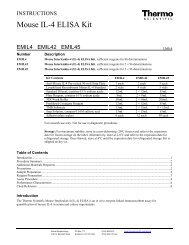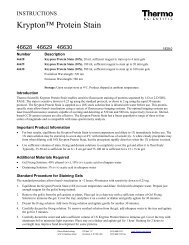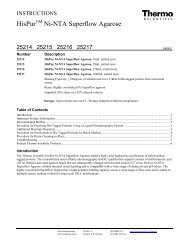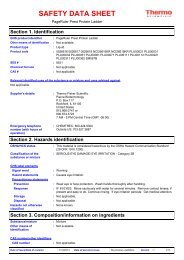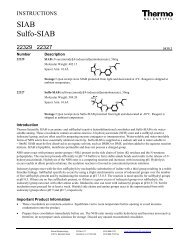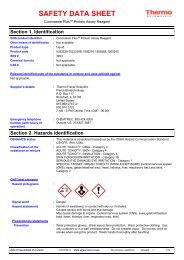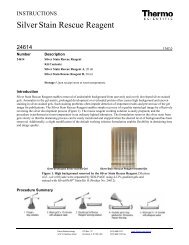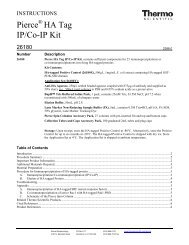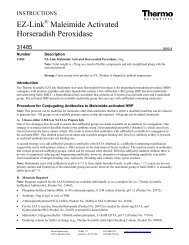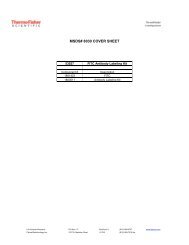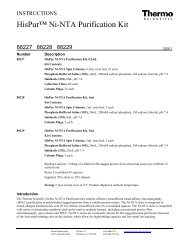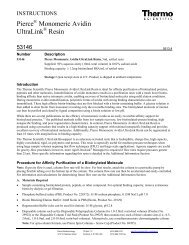Pierce Co-Immunoprecipitation (Co-IP) Kit
Pierce Co-Immunoprecipitation (Co-IP) Kit
Pierce Co-Immunoprecipitation (Co-IP) Kit
Create successful ePaper yourself
Turn your PDF publications into a flip-book with our unique Google optimized e-Paper software.
6. Remove the bottom plug, loosen the screw cap and place the column in a collection tube. Centrifuge the spin columns.<br />
Save the flow-through for future analysis.<br />
7. Remove the screw cap, place the column into a new tube, add 200µL of <strong>IP</strong> Lysis/Wash Buffer and centrifuge.<br />
8. Wash the sample two more times with 200µL <strong>IP</strong> Lysis/Wash Buffer and centrifuge after each wash.<br />
Note: Evaluate the washes (e.g., A280, SDS-PAGE or Thermo Scientific Micro BCA Protein Assay) to determine the<br />
optimal number of washes for the specific system. There should be no protein in the final wash fraction. Additional<br />
washes might be necessary for samples containing high protein concentrations.<br />
Optional Wash: To improve elution, perform an additional wash with 100µL of 1X <strong>Co</strong>nditioning Buffer. This buffer<br />
contains low salt and minimal buffer; therefore, test the flow-through to confirm that the bait:prey complex remained intact.<br />
E. Elution of <strong>Co</strong>-<strong>IP</strong><br />
Note: If the protein or antibody is sensitive to low pH, use a neutral pH system (i.e., Thermo Scientific Gentle Elution Buffer,<br />
Product No. 21027). For downstream enzymatic or functional assays, add 5µL of 1M Tris, pH 9.5 to the collection tube, which<br />
will neutralize the pH of the Elution Buffer upon centrifugation.<br />
1. Place the spin column into a new collection tube. Add 10µL of Elution Buffer and centrifuge.<br />
2. Keep the column in the tube and add 50µL of Elution Buffer. Incubate for 5 minutes at room temperature. The column<br />
does not need to be closed or mixed.<br />
Note: For a more concentrated eluate, use less Elution Buffer; however, overall yield may be reduced.<br />
3. Centrifuge the tube and collect the flow-through. Analyze the flow-through for protein. Perform additional elutions (i.e.,<br />
Steps E1-E3) as needed. Analyze each flow-through fraction separately to ensure that the antigen has completely eluted.<br />
4. To preserve activity of the antibody-coupled resin, immediately proceed to Section F, Resin Regeneration and Storage.<br />
F. Resin Regeneration and Storage<br />
1. Add 100µL of 1X <strong>Co</strong>upling Buffer to the spin column, centrifuge and discard the flow-through. Repeat this step once.<br />
2. Replace the bottom plug on the spin column. Add 200µL of 1X <strong>Co</strong>upling Buffer to spin column. Replace screw cap.<br />
Wrap the bottom of the tube with laboratory film to prevent resin from drying. For long-term storage (i.e., > 2 weeks)<br />
add sodium azide at a final concentration of 0.02%.<br />
G. Sample Preparation for SDS-PAGE Analysis<br />
1. Equilibrate the 5X Lane Marker Sample Buffer to room temperature. Gently mix the sample buffer by inverting 5-<br />
10 times. For a reducing gel, add 1M DTT to a final concentration of 100mM in the 5X Sample Buffer.<br />
2. Add 5X Sample Buffer to sample to make a 1X final solution (i.e., add 5µL 5X Sample Buffer to 20µL of sample).<br />
3. Heat the sample at 95-100°C for ~5 minutes. Allow the sample to cool to room temperature before applying to the gel.<br />
<strong>Pierce</strong> Biotechnology PO Box 117 (815) 968-0747 www.thermoscientific.com/pierce<br />
3747 N. Meridian Road Rockford, lL 61105 USA (815) 968-7316 fax<br />
5



